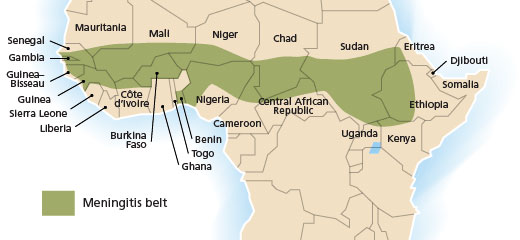
Control of epidemic meningococcal disease, WHO practical guidelines, World Health Organization, 1998, 2nd edition, WHO/EMC/BAC/98.3
The African meningitis belt.
A new and improved low-cost vaccine against Meningitis A received the formal quality stamp of approval from the World Health Organization (WHO) last week, a move that offers great promise for the 430 million people at risk of the disease in Sub-Saharan Africa’s so-called Meningitis Belt. But Doctors Without Borders/Médecins Sans Frontières (MSF) warns that the full roll out of this much-needed vaccine depends on sufficient funds being mobilized.
“This new vaccine opens up whole new possibilities,” said Dr. Cathy Hewison, medical advisor at MSF. “In 2009, MSF vaccinated more than 7 million people for Meningitis A, but until now we have been confined to emergency response, trying to slow and stop epidemics. The existing vaccine confers very short-term protection, limiting the effectiveness of our current response to outbreaks. This new vaccine gives four times greater protection and lasts ten years. It's a game changer to prevent epidemics in the future.”
Aside from the medical significance of the new vaccine, the development of this new product is the proof that innovative models for vaccine development can deliver. The WHO, in collaboration with the non-profit organization PATH, have put medical needs and final product affordability at the forefront of the development process. An Indian manufacturer, the Serum Institute of India, acted as the development partner and will manufacture the vaccine at an agreed starting price of 40 cents per dose.
“This is a complete revolution compared to the usual patent-based, profit-driven model,” said Dr. Tido Von Schoen-Angerer, director of the MSF Campaign for Access to Essential Medicines. “Its developers have succeeded in tailoring the product to suit developing country medical needs and keeping the vaccine affordable. This is a striking contrast to the blockbuster vaccines developed by the largest commercial developers for Western markets that fetch extremely high prices and aren’t produced with developing country needs in mind.”
Three countries—Mali, Burkina Faso and Niger—will start mass vaccination campaigns this autumn with the support of the Global Alliance for Vaccines and Immunization (GAVI) and WHO. But the next step is to ensure that this vaccine reaches all those at-risk in the countries of the Meningitis Belt. WHO estimates that it will cost $475 million to roll the vaccine out in the 22 additional countries with highest need.
For more information, visit www.meningvax.org/epidemics-africa.php




